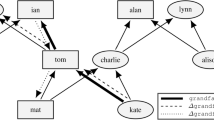Abstract
This paper gives algorithms to compute the explanation of instance membership in classes over an Inference Hierarchy. O(c) time algorithms are given to compute the positive, negative, and conditional explanations over an Inference Hierarchy limited to conjunctive parents, where c is the total number of conditions in the Inference Hierarchy.1 Algorithms requiring O(c 2 k) time and space are given for computing the k-minimal positive, negative and conditional explanations over disjunctive hierarchies with independent conditions. Worst-case exponential time is required for computing negative and negative conditional explanations over disjunctive hierarchies with dependent conditions. All types of explanation are worst-case exponential time for the k-minimal explanations over hierarchies using negation in parent relationships. An application for these algorithms is provided. The application is motivated by the DARPA ALP storyboard and provides active mediation of airport facility status in a combat situation. These techniques may be transferred to financial, administrative, and environmental domains as well.
Similar content being viewed by others
References
W. Kim (</del>Ed.), Modern Database Systems: The Object Model, Interoperability and Beyond, Addison-Wesley: Reading, Massachusetts, 1994.
T. Winograd, Understanding Natural Language, Academic Press, New York, 1972.
E. Shortliffe, Computer Based Medical Consultations: MYCIN, Elsevier North Holland Inc., 1976.
W. Swartout, C. Paris, and J. Moore, "Design for explainable expert systems," IEEE Expert, vol. 6, no. 3, pp. 58-64, 1991.
G. Brewka and K. Konolige, "An abductive framework for generalized logic programs and other nonmonotonic systems," in IJCAI-93, 1993.
T. Mitchell, R.M. Keller, and S. Kedar-Cabelli, "Explanationbased generalization: A unifying view," Technical Report MLTR-2, SUNJ Rutgers U, 1985.
M. Pazzani, M. Dyer, and M. Flowers, "Using prior learning to facilitate the learning of new causal theories," in Proceedings of the 10th International Joint Conference on Artificial Intelligence, Milan, Italy, August 1987, pp. 277-279.
R.J. Brachman and J.G. Schmolze, "An overviewof theKL-ONE knowledge representation system," Cognitive Science, vol. 9, no. 2, pp. 171-216, 1985.
R. MacGregor and M. Burstein, "Using a descriptive classifier to enhance knowledge representation," IEEE Expert, vol. 6, no. 3, pp. 41-47, 1991.
D. McGuinness, "Explaining reasoning in description logics," Ph.D. Thesis, Rutgers, The State University of NewJersey, 1996.
G. Parke, "Minimization in cooperative response to failing database queries," Technical Report CS-TR-3348, University of Maryland Institute for Advanced Computer Studies Dept. of Computer Science, Univ. of Maryland, College Park, MD, 1994.
R. Reiter, "On closed world databases," Logic and Databases, Plenum Press, 1978.
Author information
Authors and Affiliations
Rights and permissions
About this article
Cite this article
Minock, M., Chu, W. Explanation Over Inference Hierarchies in Active Mediation Applications. Applied Intelligence 13, 101–112 (2000). https://doi.org/10.1023/A:1008332327305
Issue Date:
DOI: https://doi.org/10.1023/A:1008332327305




